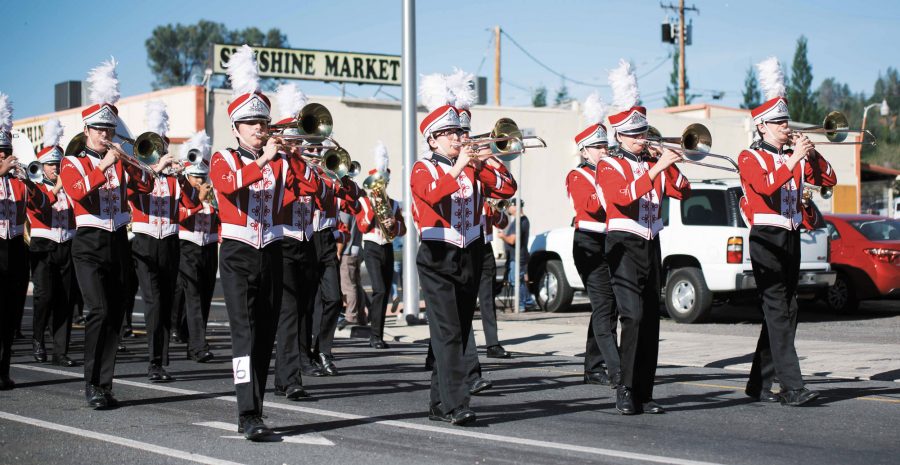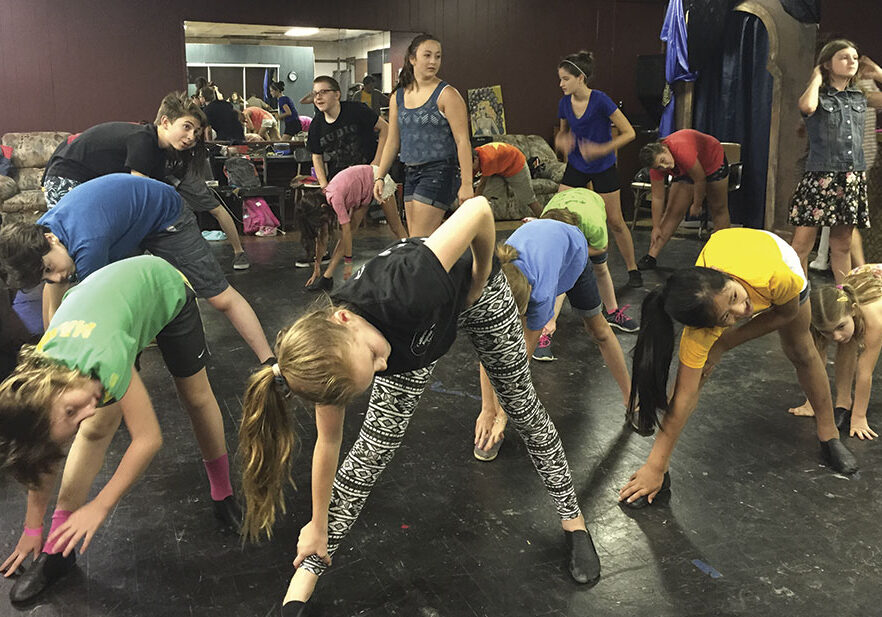Despite perennial funding concerns, the drums of high school bands still beat loud and clear across the North State, and not just in music rooms and concert halls. Marching bands—typically a component of high school band programs rather than a separate class—sally forth into their communities, energizing events, honoring veterans, and delighting families.
Marching band season frequently accompanies football season. Columns of high-stepping musicians form words and patterns across the field at halftime fueling school spirit, but marching bands also bring pizzazz to events throughout the year.
Although typically less intricate than concert band music, marching band songs still demand hours of practice outside class to memorize, growing students’ perseverance and discipline. Bob Schofield, band director at Paradise High School, describes a two-minute halftime song as “two minutes of the hardest concentration you’ll do. There’s so much to focus on, staying in line, staying in step, and playing to the best of your ability.”
The venue provides an extra challenge without the walls of a concert hall to contain the sound, and marching band players must project their sound with extra confidence. “It’s a very insecure feeling at first,” says Mitch Bahr, Foothill High School’s music director. “There is also increasing expectation to move and dance, and it’s got to look tight. Band teaches kids how to get out and risk being vulnerable doing something they never thought they could do. That’s my favorite part of being a band director.”
Not every band program includes a marching band. Out of 25 high school bands in Butte, Glenn, Shasta, Siskiyou, and Tehama counties, 15 have a marching band. As Mount Shasta High School band director Greg Eastman explains, “Up here [in rural Northern California] it’s just a numbers game. It’s not that we don’t value the marching band. Many schools like us often don’t have enough students or resources to create a successful marching band.” Small schools can get creative. Mount Shasta High School’s program includes a new drumline, designed to perform at sports and community events in the stead of a full marching band.
Band teaches students to take personal responsibility, and marching accentuates this life lesson. It requires students to keep track of their instruments and uniforms as they move from place to place. “Marching band teaches students to pull their own weight to make sure the event happens. Even an afterschool practice can’t happen if they’re not there to move the equipment,” explains Cory Goga, director of Orland High School’s 60-student band.
Smaller bands feel the value of each player even more keenly. Bob Schofield’s Pride of Paradise band shrunk by half after the 2018 Camp Fire. With only 20 members, each player’s presence becomes critical, especially when marching in formation. At the same time, such a small group creates an even deeper sense of ownership and belonging, especially valuable after trauma. Playing music together offers Paradise students a sense of normalcy independent of physical location.
Belonging to a marching band gives students practice at working with others, a valuable skill “even if they don’t pursue music after high school,” Cory says. Adriana Jimenez, the band director at Corning High School, agrees. “Band teaches kids how to be leaders, but also how to be followers who can step into leadership if needed. I think that’s really important.” Both Adriana and Cory identify improved social skills as a benefit of band, especially for those who take on leadership positions like drum major. “Leading peers is difficult,” Cory says. “I really admire the kids who do that successfully. They work hard for it, and it sets them up for success.”
Marching band isn’t just for high school students. Deb Wiseman teaches band at Sequoia Middle School in Redding, CA. This year, her students are perfecting “This Is My Country” for patriotic events, “I’ll be Home for Christmas” for the local Hometown Holidays parade, and the Star Wars theme song to perform in Disneyland. While qualifying to play at Disneyland greatly motivates kids, a simple achievement often offers the greatest motivation. Deb recalls a struggling student, thrilled to finally pass three short songs, leaping up after the test and asking, “May I do a happy dance?”
Although she teaches middle school, Deb teaches her students with their futures in mind. “Being in band does not mean sacrificing sports or other activities. Colleges are looking for well-rounded people.” Many of Deb’s students continue with band through high school and into college, and some have even started teaching music themselves.
Perhaps best of all, marching bands allow musicians to go out to give the gift of music rather than depend on audiences to come to them. Corning High School students play Christmas music at a senior center every year. They also hold the exclusive privilege of playing at Adaptive Sports Day, a Chico State University event for kids with needs that prevent them from participating in most physical education activities. Mitch Bahr’s Foothill High School Band recently received an American flag from the Korean War Veterans Society in gratitude for the school’s performances. “I tell the kids that a parade is a service to the community,” Mitch says. “It’s an opportunity to give back.”
Surrounded by the hearty support of their communities, high school marching bands show good promise of continuing to give back for many years to come. As students give back through music, they gain even more in return. Marching band provides an active team experience where no one sits on the bench. From teamwork to perseverance and self-confidence, marching band offers youth in the North State excellent opportunities to gain valuable skills and learn transferable life lessons about music, others, and themselves.
Posted in: Community
Comment Policy: All viewpoints are welcome, but comments should remain relevant. Personal attacks, profanity, and aggressive behavior are not allowed. No spam, advertising, or promoting of products/services. Please, only use your real name and limit the amount of links submitted in your comment.
You Might Also Like...

Spring Birthday? Pull Together A Quick & Inexpensive Indoor Garden Party
Are you looking for an easy and fun spring birthday party celebration for elementary school-age children? Browse these ideas and pick and choose what works for your spring birthday girl […]

Recycle Unused Paint with PaintCare
“It’s the Goldilocks problem,” jokes Paul Fresina, communications director of PaintCare Inc. When it comes to buying paint, he says, “We’re looking for ‘just right,’ but sometimes we buy too […]

Is Your Family Pet a “Canine Good Companion?”
Anna Hemstalk, of Hemstalk Canine Companions, is an inspirational voice in her chosen field. She is an American Kennel Club evaluator and trainer, committed to the positive influence she knows […]
Cuddle A Reader, Create A Reader – A Special Message And More For New Parents
“It’s never too early to start reading to your child.” This is the message that parents of newborns are hearing at Dignity Health Mercy Medical Center Redding (MMCR) before they […]



